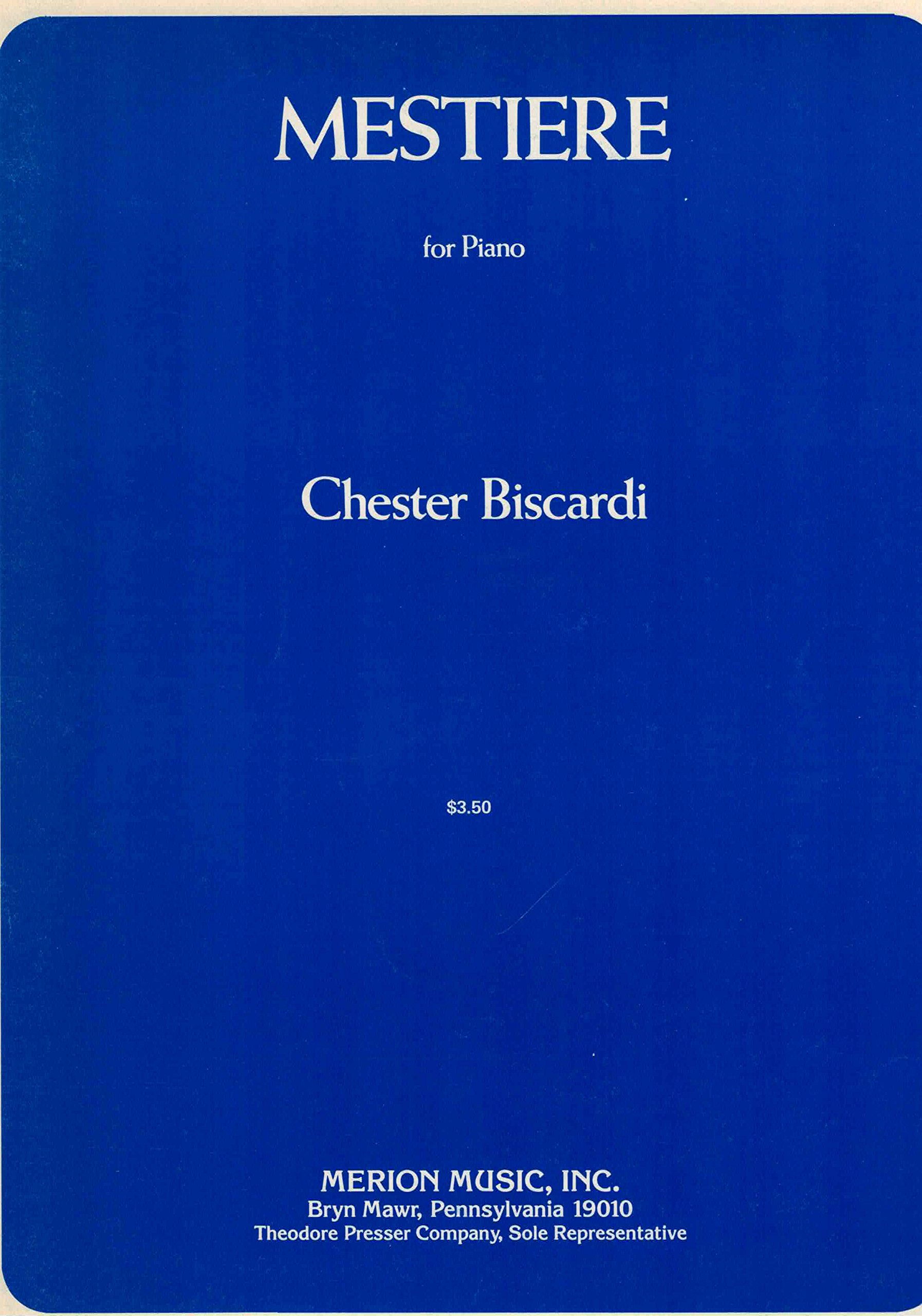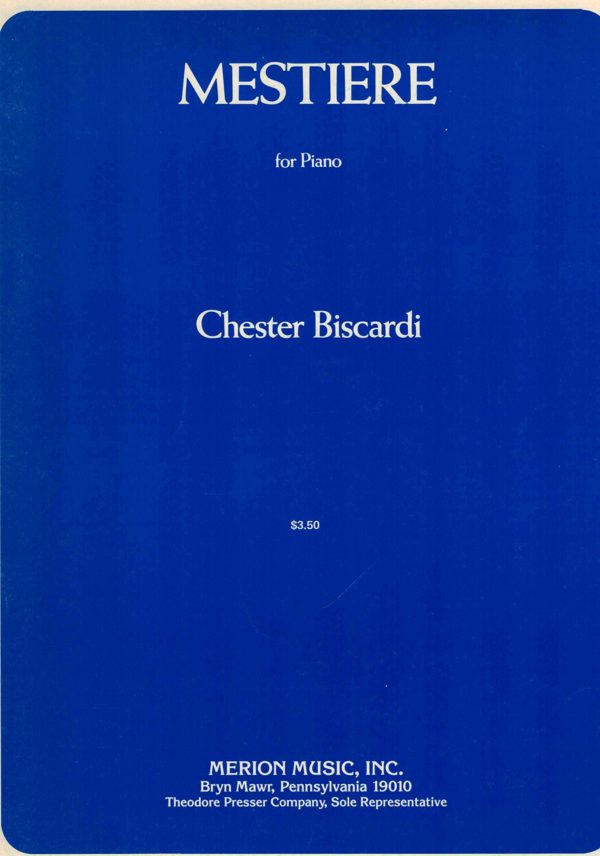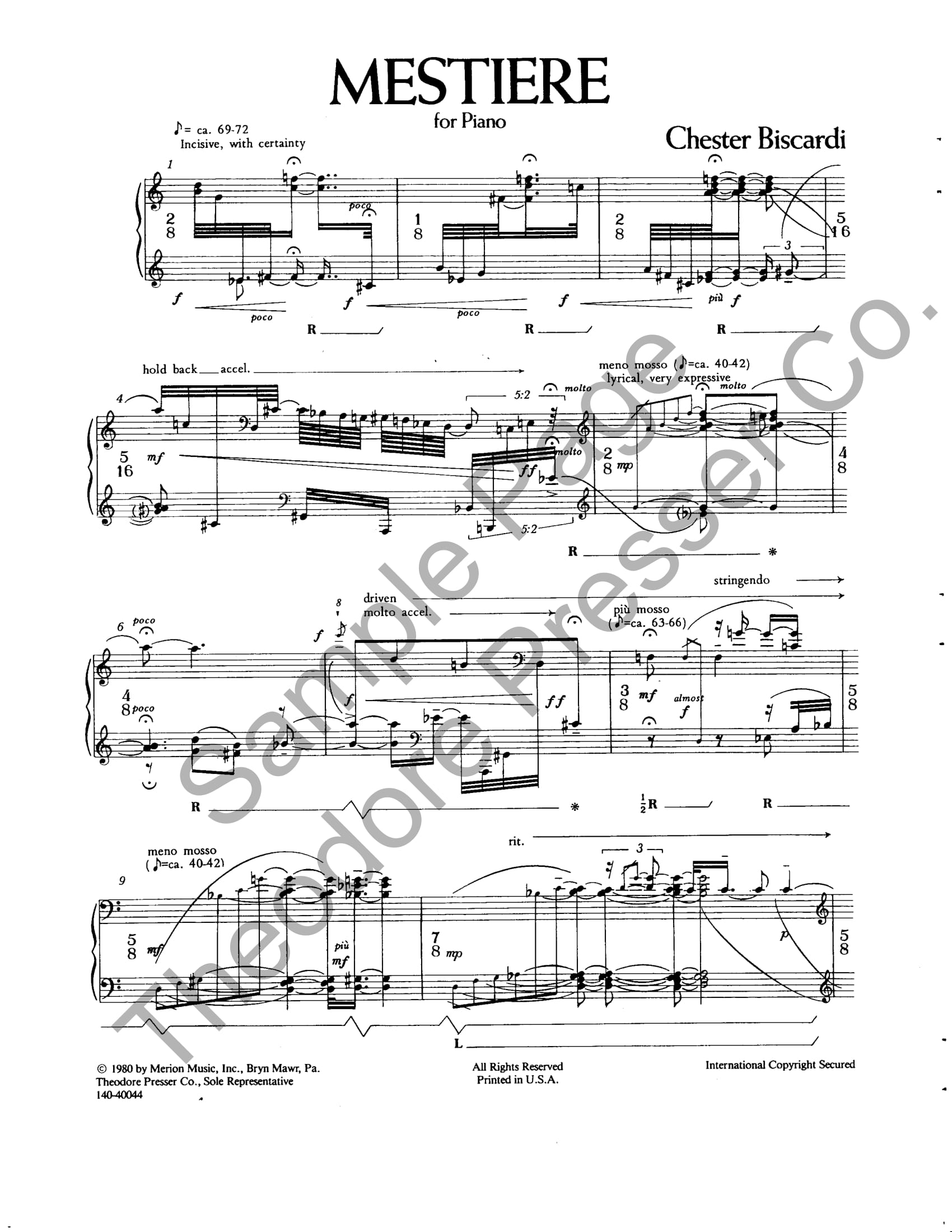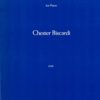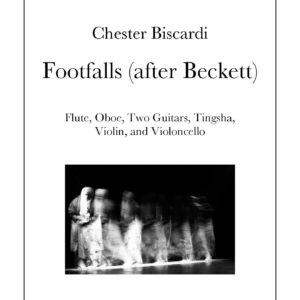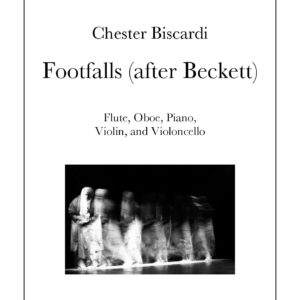Description
Audio
Robert Weirich, piano
This recording appears on
Chester Biscardi: At the Still Point, New World Records/CRI NWCR686 (New York, 1995) with
Traverso,
The Gift of Life,
Companion Piece (for Morton Feldman),
Incitation to Desire (Tango),
Tenzone, and
At the Still Point.
Premiere
4 March 1979
Robert Weinrich, piano
Festival of Piano Music: Tulane University
New Orleans, LA
Dedication
to Robert Weirich
Commissioner
Tulane University for the Festival of Piano Music, 1979, under a grant from the Andrew W. Mellon Foundation for the Enrichment of the Humanities
Publisher
Merion Music, Inc./Theodore Presser Co. No. 140-40044
Program Notes
Mestiere, for piano (1979), was commissioned by Tulane University for the 1979 Festival of Piano Music in New Orleans and is dedicated to Robert Weirich. The Festival created a context for it: my work would come on the first half of the program between Muzio Clementi’s Piano Sonata, Op. 36, No. 3, in C Major (1797) and Alexander Scriabin’s Piano Sonata No. 5, Op. 53, in F# Major (1907), followed by an alternating mix of etudes by Chopin and Debussy on the second half. Mestiere is a celebration of the contrasting sonorities – incisive and lyrical – that are natural to the piano. The Italian title can be translated as “craft, business, occupation – whatever is necessary to one’s profession or art”. By extension “Mestiere” is what one is and does, what is integral to one’s life and work. The title comes from Cesare Pavese’s collected journals, Il mestiere di vivere (1935-1950) (The Business of Living).
From the celebratory opening to the quiet, still ending, I play with sudden changes, expansions, and contractions of sounds. Dynamics and pedaling (all three are used) are gradated and subtle. I create areas of “frozen registration” from which I try to break free – a tone remains in a certain place until intuitively I feel that it must move. The freely, fast flowing music in Elliott Carter’s Piano Sonata (1945-46) resonates in this work, and there are hints of a three-note gesture and a chord from Toru Takemitsu’s Piano Distance (1961) where the music is the direct and natural result of sounds themselves. There is a direct quotation from the third movement, “Farben“, Mässig (“Summer Morning by a Lake: Chord-Colors”, Moderate), from Arnold Schoenberg’s Five Pieces for Orchestra, Op. 16 (1909). I also adapted material from my earlier works, including they had ceased to talk (1975), Trusting Lightness (1975), and Eurydice (1978).

Mestiere may be performed together with Di Vivere, for clarinet in A and piano with flute, violin and violoncello (1981), which shares the same inspiration from Pavese’s journals. Di Vivere may be performed as a quintet or a duet for clarinet in A and piano.
The quintet, the duet or the piano solo may be performed individually or in one of the following combinations:
I. Di Vivere duet and quintet
II. Mestiere and Di Vivere duet and quintet
III. Mestiere and Di Vivere quintet
IV. Mestiere and Di Vivere duet
Press
"The title, from the Italian, means 'craft.' A one-movement work, delicate yet powerful. Diverse sonorities integrated into a compelling structure. Dissonant, exploits entire keyboard range; florid, cadenza-like. Contains detailed performance instructions. Debussy Influence. Difficult."
— Maurice Hinson, Guide to the Pianist's Repertoire (1987)
"Chester Biscardi's 'Mestiere' is a short, sonorous work of pleasing elegance."
— John Henken, Los Angeles Times (1980)
"Complexity and virtuosity characterize Chester Biscardi's dramatic
Mestiere, here boldly performed by pianist Robert Weirich, for whom it was written. Taking its title from an Italian word meaning "craft" or "business,' the work successfully exploits sonorities idiomatic to the piano."
— Michael Meckna, American Record Guide (1982)
"The most rewarding work here is Chester Biscardi's. It offers a remarkable integration of diverse sonorities into a compelling structure. It all grows out of a striking beginning, and the use of the piano's pedals is very telling. All in all a sensible, sensitive work."
— Fanfare Magazine (1983)
"Biscardi's music is clear-lined and remarkably accessible in its expressivity."
— Fanfare Magazine (1988)
"All the works by Biscardi share a common ground in that they are expressive, sensitive and convincing."
— American Record Guide (1988)
In
Mestiere (1979) . . . something new begins to emerge. Out of the initial dramatic, dissonant opening, soon more lyrical lines and rich, quasi-tonal harmonies emerge. The whole piece seems to be a dialog between the composer Biscardi has been taught to be and the one he wants to be. In the end, it seems the latter wins the contest, and subsequent pieces confirm that verdict.
— Robert Carl, Fanfare, The Magazine for Serious Record Collectors (1995)
The 1979
Mestiere for solo piano is . . . rhapsodic, with highly idiomatic piano figuration throughout, which creates Impressionistic sonic scrims that project lovely layers of harmony.
— Robert Carl, Fanfare: The Magazine for Serious Record Collectors (January 2012)
Mestiere (craft) is a short piano piece written for the 1979 New Orleans Festival of Piano Music. Carter (
Piano Sonata) and Takemitsu (
For Away) are cited as influences, and there's a reference to Schoenberg's
Farben thrown in for good measure. The result is improvisational-sounding and a little scattered, though that is the way dreams tend to be.
— Byzantion, MusicWeb International Classical Reviews (September 11, 2011)
Mestiere and
Di Vivere are companion works of a sort, in that their titles are taken from two halves of the collected journals of twentieth century Italian writer Cesare Pavese (1908-50),
Il Mestiere di Vivere ('The Business of Living'). Biscardi says that they may be performed together,
Di Vivere either as a quintet for clarinet in A and piano, with flute, violin and cello, as here, or as a duo for the clarinet and piano alone.
Mestiere is a short, ponderous, atonal piece, and serves as a prelude to the more immediately attractive
Di Vivere, which was commissioned by and premiered in 1982 by the Da Capo Players themselves – flautist Patricia Spencer and cellist André Emilianoff are, amazingly, still in this splendid ensemble's line-up.
— Allen Gimbel, American Record Guide (November/December 2011)



